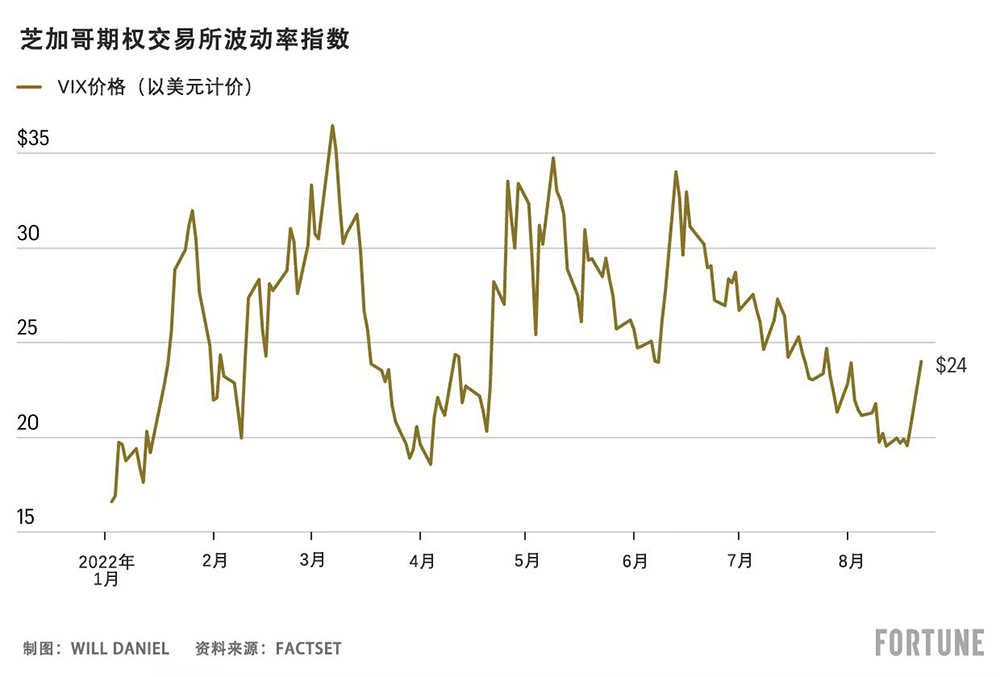
8月22日,道瓊斯工業(yè)平均指數(shù)(Dow Jones Industrial Average)下跌超過600點(diǎn),,原因是投資者再次對(duì)美聯(lián)儲(chǔ)(Federal Reserve)的激進(jìn)加息感到擔(dān)憂,,結(jié)束了今年夏季的股市反彈。
與此同時(shí),,芝加哥期權(quán)交易所(Chicago Board Options Exchange)的波動(dòng)率指數(shù)(Volatility Index)在8月22日上升了近17%,。波動(dòng)率指數(shù)又被稱為華爾街的“恐慌指數(shù)”。
1987年黑色星期一股市崩盤之后誕生的波動(dòng)率指數(shù),,用于衡量美國(guó)股市的預(yù)期波動(dòng)率,。該指數(shù)基于標(biāo)準(zhǔn)普爾500指數(shù)(S&P 500)看漲和看跌期權(quán)的實(shí)時(shí)價(jià)格,自2008年金融危機(jī)以來(lái)在華爾街被廣泛應(yīng)用,。
期權(quán)是一種衍生品,,使投資者有權(quán)利(但沒有義務(wù))在指定日期或指定日期之前按照特定價(jià)格買入或賣出一種標(biāo)的資產(chǎn)。
波動(dòng)率指數(shù)之所以又被稱為“恐慌指數(shù)”,,是因?yàn)樗糜诤饬渴袌?chǎng)波動(dòng)率或者價(jià)格變化速度,,可以用來(lái)評(píng)估投資者和交易商的情緒,。
它的工作原理是:當(dāng)投資者和交易商擔(dān)心股市的未來(lái)時(shí),他們更可利用期權(quán)幫助保護(hù)其投資組合,。這反過來(lái)會(huì)推高波動(dòng)率指數(shù),,讓其他投資者意識(shí)到他們的同行感覺到了危險(xiǎn)。

專家們對(duì)《財(cái)富》雜志表示,,8月22日,,有多個(gè)關(guān)鍵因素幫助推高了波動(dòng)率指數(shù)。
首先,,8月22日是俄羅斯民族主義哲學(xué)家,、弗拉基米爾·普京總統(tǒng)的“精神導(dǎo)師”亞歷山大·杜金的女兒達(dá)里婭·杜金娜被刺殺之后的第一個(gè)交易日。交易商預(yù)計(jì),,普京可能針對(duì)此次刺殺采取反擊,,進(jìn)一步減少對(duì)歐洲的天然氣供應(yīng),并認(rèn)為此次刺殺事件只會(huì)延長(zhǎng)俄烏沖突的時(shí)間,。
聯(lián)信銀行(Comerica Bank)的首席經(jīng)濟(jì)學(xué)家比爾·亞當(dāng)斯告訴《財(cái)富》雜志:“在歐洲迎來(lái)冬季能源短缺和經(jīng)濟(jì)嚴(yán)重下滑之前,,俄烏沖突平息的可能性越來(lái)越低?!?/p>
除此之外,,8月22日也是俄羅斯國(guó)有能源巨頭俄羅斯天然氣工業(yè)股份公司(Gazprom)宣布北溪1號(hào)(Nord Stream 1)管道再次進(jìn)行計(jì)劃外維護(hù)之后的第一個(gè)交易日。北溪1號(hào)將俄羅斯的天然氣通過波羅的海輸送到德國(guó),。
隨著天然氣價(jià)格創(chuàng)歷史新高,,批評(píng)者認(rèn)為俄羅斯利用這條管道懲罰對(duì)其實(shí)施制裁的歐洲國(guó)家,并“脅迫”各國(guó)使用俄羅斯盧布購(gòu)買天然氣,。
由于北溪1號(hào)管道維護(hù)和杜金娜遇刺身亡,,8月22日,美國(guó)和歐洲的天然氣價(jià)格暴漲,,作為歐洲天然氣基準(zhǔn)的荷蘭TTF天然氣期貨價(jià)格上漲19%,,達(dá)到每兆瓦時(shí)291.90美元。
但波動(dòng)率指數(shù)的大幅上升,,不只是因?yàn)闅W洲出現(xiàn)能源短缺的可能性增加,。投資者擔(dān)心,盡管持續(xù)通脹導(dǎo)致經(jīng)濟(jì)增長(zhǎng)停滯,,歐美各國(guó)央行將不得不繼續(xù)加息,,進(jìn)而增加了西方爆發(fā)更嚴(yán)重經(jīng)濟(jì)衰退的可能性。
安永-博智?。‥Y-Parthenon)的首席經(jīng)濟(jì)學(xué)家格雷格·達(dá)科說:“對(duì)歐洲通脹持續(xù)上升的預(yù)期以及對(duì)各國(guó)央行采取激進(jìn)緊縮政策的擔(dān)憂,,讓投資者變得高度緊張?!彼€表示,,“在可預(yù)測(cè)的未來(lái),,市場(chǎng)將依舊處于一個(gè)高度動(dòng)蕩的環(huán)境?!?/p>
除了對(duì)經(jīng)濟(jì)衰退的擔(dān)憂和歐洲的能源危機(jī)以外,,波動(dòng)率指數(shù)上升的另外一個(gè)潛在原因是,交易商試圖在最近喜憂參半的經(jīng)濟(jì)新聞的沖擊下,,從市場(chǎng)波動(dòng)中獲利,。
近幾年,隨著與指數(shù)掛鉤的交易所交易基金(ETF)和衍生品的興起,,波動(dòng)率指數(shù)交易變成了一個(gè)小型產(chǎn)業(yè),。位于休斯頓的投資公司Sanders Morris Harris的董事長(zhǎng)喬治·保爾指出,波動(dòng)率指數(shù)“對(duì)投資者而言是從市場(chǎng)波動(dòng)中獲利的一種高效的,、低成本,、流動(dòng)性的方式,前提是投資者對(duì)市場(chǎng)漲跌的判斷準(zhǔn)確,?!?/p>
保爾表示,隨著波動(dòng)率指數(shù)交易的增長(zhǎng),,該指數(shù)將不再像以前一樣,,充分代表市場(chǎng)的“恐慌”或“貪婪”。但他認(rèn)為,,該指數(shù)依舊是“個(gè)人和機(jī)構(gòu)管理投資組合風(fēng)險(xiǎn)的一個(gè)主要工具”,,其作為衡量投資者情緒的指標(biāo),重要性不容忽視,。
他說:“波動(dòng)率指數(shù)已經(jīng)變成了抵消波動(dòng)性的黃金標(biāo)準(zhǔn)。因此,,它是一種非常高效的機(jī)制,,盡管它所采用的看跌/看漲比率與市場(chǎng)上漲或下跌的關(guān)聯(lián)度較為寬松?!?財(cái)富中文網(wǎng))
譯者:劉進(jìn)龍
審校:汪皓
8月22日,,道瓊斯工業(yè)平均指數(shù)(Dow Jones Industrial Average)下跌超過600點(diǎn),原因是投資者再次對(duì)美聯(lián)儲(chǔ)(Federal Reserve)的激進(jìn)加息感到擔(dān)憂,,結(jié)束了今年夏季的股市反彈,。
與此同時(shí),芝加哥期權(quán)交易所(Chicago Board Options Exchange)的波動(dòng)率指數(shù)(Volatility Index)在8月22日上升了近17%,。波動(dòng)率指數(shù)又被稱為華爾街的“恐慌指數(shù)”,。
1987年黑色星期一股市崩盤之后誕生的波動(dòng)率指數(shù),用于衡量美國(guó)股市的預(yù)期波動(dòng)率,。該指數(shù)基于標(biāo)準(zhǔn)普爾500指數(shù)(S&P 500)看漲和看跌期權(quán)的實(shí)時(shí)價(jià)格,,自2008年金融危機(jī)以來(lái)在華爾街被廣泛應(yīng)用,。
期權(quán)是一種衍生品,使投資者有權(quán)利(但沒有義務(wù))在指定日期或指定日期之前按照特定價(jià)格買入或賣出一種標(biāo)的資產(chǎn),。
波動(dòng)率指數(shù)之所以又被稱為“恐慌指數(shù)”,,是因?yàn)樗糜诤饬渴袌?chǎng)波動(dòng)率或者價(jià)格變化速度,可以用來(lái)評(píng)估投資者和交易商的情緒,。
它的工作原理是:當(dāng)投資者和交易商擔(dān)心股市的未來(lái)時(shí),,他們更可利用期權(quán)幫助保護(hù)其投資組合。這反過來(lái)會(huì)推高波動(dòng)率指數(shù),,讓其他投資者意識(shí)到他們的同行感覺到了危險(xiǎn),。
專家們對(duì)《財(cái)富》雜志表示,8月22日,,有多個(gè)關(guān)鍵因素幫助推高了波動(dòng)率指數(shù),。
首先,8月22日是俄羅斯民族主義哲學(xué)家,、弗拉基米爾·普京總統(tǒng)的“精神導(dǎo)師”亞歷山大·杜金的女兒達(dá)里婭·杜金娜被刺殺之后的第一個(gè)交易日,。交易商預(yù)計(jì),普京可能針對(duì)此次刺殺采取反擊,,進(jìn)一步減少對(duì)歐洲的天然氣供應(yīng),,并認(rèn)為此次刺殺事件只會(huì)延長(zhǎng)俄烏沖突的時(shí)間。
聯(lián)信銀行(Comerica Bank)的首席經(jīng)濟(jì)學(xué)家比爾·亞當(dāng)斯告訴《財(cái)富》雜志:“在歐洲迎來(lái)冬季能源短缺和經(jīng)濟(jì)嚴(yán)重下滑之前,,俄烏沖突平息的可能性越來(lái)越低,。”
除此之外,,8月22日也是俄羅斯國(guó)有能源巨頭俄羅斯天然氣工業(yè)股份公司(Gazprom)宣布北溪1號(hào)(Nord Stream 1)管道再次進(jìn)行計(jì)劃外維護(hù)之后的第一個(gè)交易日,。北溪1號(hào)將俄羅斯的天然氣通過波羅的海輸送到德國(guó)。
隨著天然氣價(jià)格創(chuàng)歷史新高,,批評(píng)者認(rèn)為俄羅斯利用這條管道懲罰對(duì)其實(shí)施制裁的歐洲國(guó)家,,并“脅迫”各國(guó)使用俄羅斯盧布購(gòu)買天然氣。
由于北溪1號(hào)管道維護(hù)和杜金娜遇刺身亡,,8月22日,,美國(guó)和歐洲的天然氣價(jià)格暴漲,作為歐洲天然氣基準(zhǔn)的荷蘭TTF天然氣期貨價(jià)格上漲19%,,達(dá)到每兆瓦時(shí)291.90美元,。
但波動(dòng)率指數(shù)的大幅上升,不只是因?yàn)闅W洲出現(xiàn)能源短缺的可能性增加,。投資者擔(dān)心,,盡管持續(xù)通脹導(dǎo)致經(jīng)濟(jì)增長(zhǎng)停滯,歐美各國(guó)央行將不得不繼續(xù)加息,進(jìn)而增加了西方爆發(fā)更嚴(yán)重經(jīng)濟(jì)衰退的可能性,。
安永-博智?。‥Y-Parthenon)的首席經(jīng)濟(jì)學(xué)家格雷格·達(dá)科說:“對(duì)歐洲通脹持續(xù)上升的預(yù)期以及對(duì)各國(guó)央行采取激進(jìn)緊縮政策的擔(dān)憂,讓投資者變得高度緊張,?!彼€表示,“在可預(yù)測(cè)的未來(lái),,市場(chǎng)將依舊處于一個(gè)高度動(dòng)蕩的環(huán)境,。”
除了對(duì)經(jīng)濟(jì)衰退的擔(dān)憂和歐洲的能源危機(jī)以外,,波動(dòng)率指數(shù)上升的另外一個(gè)潛在原因是,,交易商試圖在最近喜憂參半的經(jīng)濟(jì)新聞的沖擊下,從市場(chǎng)波動(dòng)中獲利,。
近幾年,,隨著與指數(shù)掛鉤的交易所交易基金(ETF)和衍生品的興起,波動(dòng)率指數(shù)交易變成了一個(gè)小型產(chǎn)業(yè),。位于休斯頓的投資公司Sanders Morris Harris的董事長(zhǎng)喬治·保爾指出,,波動(dòng)率指數(shù)“對(duì)投資者而言是從市場(chǎng)波動(dòng)中獲利的一種高效的、低成本,、流動(dòng)性的方式,,前提是投資者對(duì)市場(chǎng)漲跌的判斷準(zhǔn)確?!?/p>
保爾表示,,隨著波動(dòng)率指數(shù)交易的增長(zhǎng),該指數(shù)將不再像以前一樣,,充分代表市場(chǎng)的“恐慌”或“貪婪”,。但他認(rèn)為,該指數(shù)依舊是“個(gè)人和機(jī)構(gòu)管理投資組合風(fēng)險(xiǎn)的一個(gè)主要工具”,,其作為衡量投資者情緒的指標(biāo),,重要性不容忽視。
他說:“波動(dòng)率指數(shù)已經(jīng)變成了抵消波動(dòng)性的黃金標(biāo)準(zhǔn),。因此,,它是一種非常高效的機(jī)制,,盡管它所采用的看跌/看漲比率與市場(chǎng)上漲或下跌的關(guān)聯(lián)度較為寬松,。”(財(cái)富中文網(wǎng))
譯者:劉進(jìn)龍
審校:汪皓
The Dow Jones Industrial Average sank over 600 points on August 22 as fears of aggressive interest rate hikes by the Federal Reserve crept back into investors’ minds, putting an end to this summer’s stock market rally.
At the same time, the Chicago Board Options Exchange’s Volatility Index (VIX), also known as Wall Street’s “fear gauge,” jumped nearly 17% to start the week.
The VIX was created after the Black Monday crash of 1987 as a way to measure the expected volatility of the U.S. stock market. It’s derived from real-time prices of S&P 500 call and put options, and has become widely used on Wall Street since the 2008 financial crisis.
Options, also known as derivatives, give investors the right—but not the obligation—to buy or sell an underlying asset at a specific price on or before a specified date.
The VIX has been given the moniker the “fear gauge,” because of its role in measuring volatility, or how fast prices change, which is seen as a way to gauge the sentiment of investors and traders.
It works something like this: When investors and traders become worried about the future of the stock market, they’re more likely to use options to help protect their portfolios. This, in turn, causes a rise in the VIX that helps other investors recognize that their peers are sensing danger.
Experts told Fortune that there were several key factors that helped push the VIX higher on August 22.
First, August 22 was the first trading day since the assassination of Daria Dugina, the daughter of the Russian nationalist philosopher and President Vladimir Putin’s “spiritual guide” Alexander Dugin. Traders are expecting Putin to respond to the assassination with further cuts to Europe’s natural gas supplies, and are betting that it will only help to extend the Russia-Ukraine war.
“The Russia-Ukraine war looks increasingly unlikely to wind down before it causes winter energy shortages and a severe downturn in Europe,” Bill Adams, Comerica Bank’s chief economist, told Fortune.
On top of that, August 22 was the first trading day since Russia’s state-owned energy giant Gazprom announced another unscheduled maintenance period for the Nord Stream 1 pipeline that carries natural gas from Russia to Germany via the Baltic Sea.
With natural gas prices at record highs, critics say Russia has used the pipeline as a way to punish European nations for their sanctions and “blackmail” countries into using Russian rubles to purchase natural gas supplies.
Natural gas prices in the U.S. and Europe spiked on August 22 as a result of Nord Stream 1 pipeline maintenance and Dugina’s assassination, with Dutch TTF gas futures, a European benchmark for natural gas, rising 19% to reach $291.90 per megawatt hour.
But the surge in the VIX is about more than just the increasing chance of a European energy shortage. Investors are worried that central banks will be forced to continue raising interest rates in the U.S. and Europe even as economic growth stalls due to persistent inflation, thereby increasing the odds of a more severe recession in the West.
“Expectations of an ongoing surge in inflation in Europe along with the sentiment that central banks will pursue aggressive tightening is making investors extremely anxious,” said Greg Daco, EY-Parthenon’s chief economist, adding that he believes the markets will remain in “a highly volatile environment for the foreseeable future.”
Beyond recession fears and Europe’s energy crisis, another potential reason for the VIX’s rise could be that traders are attempting to make a profit off market swings amid the recent onslaught of mixed economic news.
Trading on the VIX has become a cottage industry in recent years due to the rise of exchange-traded funds (ETFs) and derivatives tied to the index. George Ball, the chairman of Sanders Morris Harris, a Houston-based investment firm, noted that the VIX is “an efficient, low-cost, liquid way for investors to profit from market swings, up or down—assuming the investor is right about the direction.”
Because of the growth of VIX trading, Ball said that the VIX isn’t as good a representation of the market’s “fear” or “greed” as it used to be. Still, he noted that the index is still “primarily a tool to manage portfolio risk, both for individuals and institutions” and shouldn’t be discounted as a measure of investor sentiment altogether.
“It has become the gold standard for offsetting volatility,” he said. “As a result, it is quite efficient as a mechanism for doing that, even though the put/call ratio that it employs is only loosely linked to the market heading up or down.”






